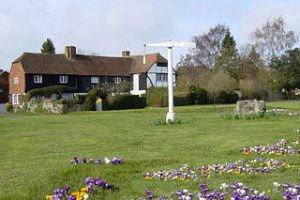
Offham lies on a hill two miles from West Malling. It is an attractive and historic Kentish ragstone village which possesses on its village green the only surviving Quintain in the country. The surrounding area is mixed farming and offers excellent walking, scenic views and riding tracks. The village has grown significantly in the last century and is now home to around 900 people.
Offham as a place first appears in a Charter of 832/3 AD in which Aethelwulf, King of Kent, presented the estate to Christ Church, Canterbury. The name derives from an ancient Saxon personal name, Offa, and ‘ham’ meaning a village, estate or homestead: ‘Offa’s village’ or ‘Offa’s home’. Both elements of the name would seem to suggest there was an early Anglo-Saxon settlement here.
Offham is included in the Domesday Book (1086) under two manors in the possession of Bishop Odo, Bishop of Bayeux, and the half-brother of William the Conqueror. The de Ofham family held both manors for much of the 12th and 13th centuries and was no doubt responsible for some of the rebuilding of the church at that time.
Offham is famous for two of the leaders of the medieval Peasants’ Revolts – Jack Straw in 1381 and Jack Cade in 1450. The Parish Registers are also remarkable for the fact they date back as far as 1538 and are among the earliest in the country. The registers record an outbreak of the plague in the summer of 1607 in which 25 people died.
Otherwise, it is the Quintain (pictured above) that brings fame to the village. Writing in 1798 in his History of Kent, Hasted wrote:
“On Offham green there stands a Quntin, a thing now rarely to be met with, being a machine much used in former times by youth, as well to try their own activity as the swiftness of their horses in running at it. The cross piece of it is broad at one end, and pierced full of holes; and a bag of sand is hung at the other and swings round, on being moved with any blow.”
Quintains were used to test the agility of horsemen. They would approach the quintain at speed and hit the broad part of the cross beam hard. Those who missed were greeted with loud shouts of derision from other onlookers. For those who did hit it, they had to watch out for the other end of the quintain which would swing around fast and hit them in the back of the head! This particular medieval sport was fabulous for testing the skill of both horse and rider. The Offham Quintain is possibly the only one still in existence in the United Kingdom.